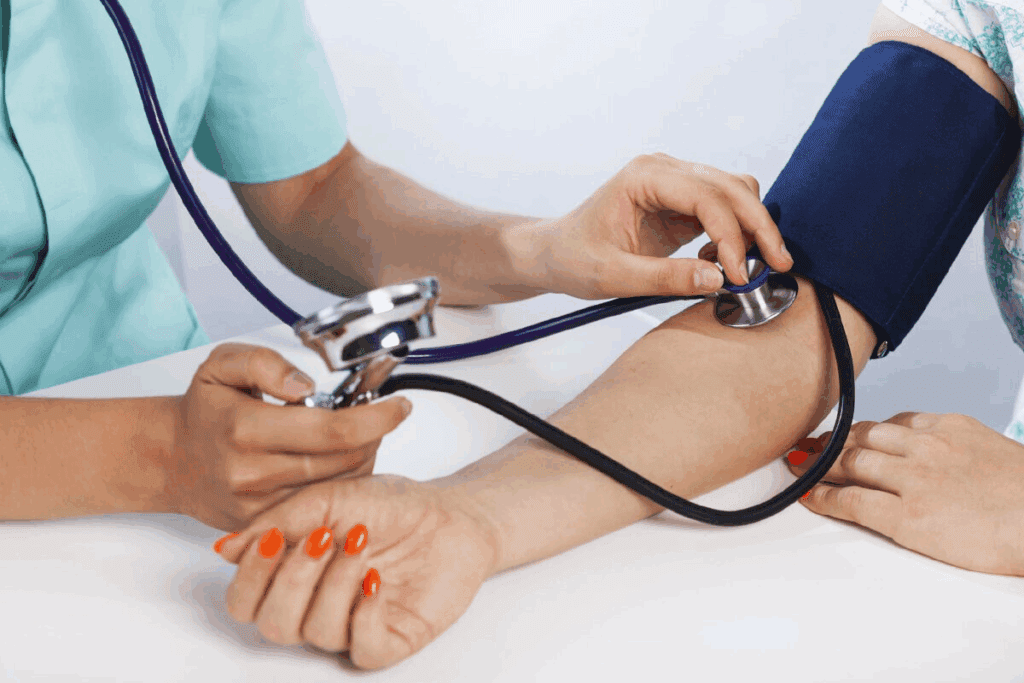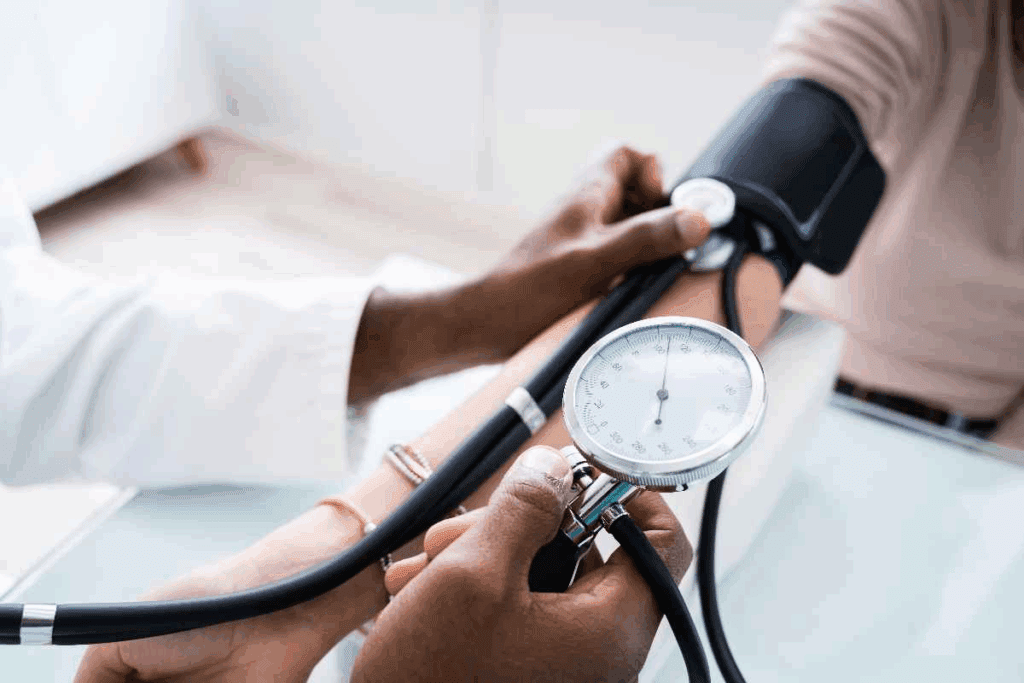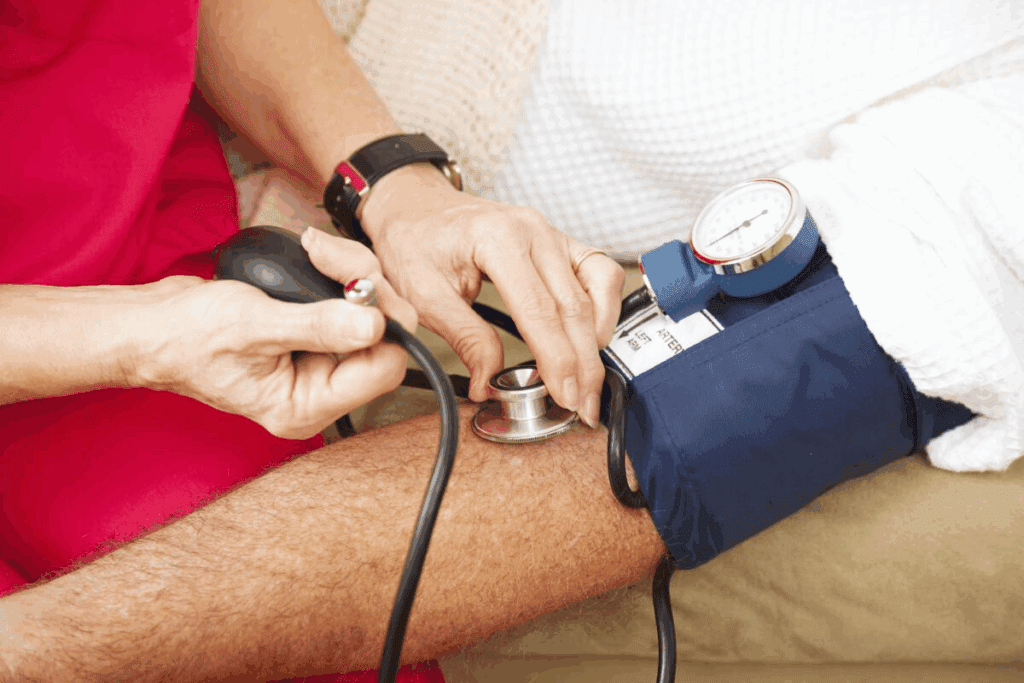Last Updated on October 31, 2025 by Batuhan Temel

Knowing your blood pressure readings is key to keeping your heart healthy. At Liv Hospital, we focus on understanding these readings carefully. High blood pressure is a big risk for heart diseases, so it’s important to know about pulse rate hypertension.
Managing hypertension is more than just checking your blood pressure. It needs a full healthcare plan. Our care is centered on you, making sure every reading is checked carefully. This gives you the info you need to keep your heart safe.

To understand pulse rate hypertension, we must first learn about blood pressure basics. Blood pressure shows how hard blood pushes against artery walls as the heart pumps. It’s a key sign of heart health.
Blood pressure is measured in millimeters of mercury (mmHg). It’s vital for checking heart health. These numbers tell us how well the heart pumps blood and the state of blood vessels.
High blood pressure, or hypertension, is a big concern. It can cause heart disease, stroke, and kidney disease if not treated.
Blood pressure has two important numbers: systolic and diastolic. Systolic pressure is the top number. It shows the highest pressure in arteries when the heart beats. Diastolic pressure is the bottom number. It shows the lowest pressure in arteries when the heart rests.
Knowing these numbers is key to managing hypertension. For example, a reading of 120/80 mmHg is normal. This means the systolic pressure is 120 and the diastolic is 80.
By understanding blood pressure basics and the importance of systolic and diastolic numbers, we can improve our heart health. This knowledge helps us take steps to keep our heart in good shape.

It’s important to know how pulse rate and hypertension are linked for heart health. We’ll look into their connection and its impact on well-being.
Heart rate and blood pressure are closely tied because they show how well the heart works. A fast heart rate might mean the heart is working too hard. This could be due to stress, anxiety, or heart problems.
A faster heart rate means more blood is pumped into the arteries with each beat. This can raise blood pressure. On the other hand, a slower heart rate might lower blood pressure, as the heart has more time to fill with blood.
For most adults, a good blood pressure is around 120/80 mmHg. A normal heart rate is between 60-100 beats per minute. But, these numbers can change based on age, fitness, and health.
| Category | Blood Pressure (mmHg) | Heart Rate (bpm) |
| Normal | 120/80 | 60-100 |
| Elevated | 120-129/80 | 100-110 |
| Hypertension Stage 1 | 130-139/80-89 | 110+ |
An elevated pulse rate can signal heart problems, like dehydration or anemia. High heart rates can strain the heart and make hypertension worse.
It’s key to check blood pressure and heart rate often, if you’re worried about heart health. Knowing how these signs are connected helps manage health better and work with doctors to fix any problems.
To get a true picture of your blood pressure, proper measurement techniques are vital. It’s not just about getting a reading. It’s about understanding what that reading means for your health.
To ensure accurate blood pressure readings, it’s important to create the right conditions. Be in a relaxed state and avoid caffeine and smoking for at least 30 minutes before. Sit comfortably with your back supported.
Proper posture is also essential; keep your feet flat on the floor and your arm at heart level.
Several common mistakes can lead to inaccurate blood pressure readings. These include using a cuff that is too small or too large, not resting before measurement, and talking or moving during the measurement.
Consistency is key; taking readings at the same time every day can help identify patterns and changes in your blood pressure.
Both home monitoring and clinical measurements have their advantages. Home monitoring allows for multiple readings over time, providing a more complete picture of your blood pressure. Clinical measurements, on the other hand, are taken in a controlled environment by healthcare professionals.
When choosing between home monitoring and clinical measurements, consider your personal needs and circumstances. Some people may benefit from a combination of both, using home readings to track changes between clinical visits.
Understanding the blood pressure measurement meaning is key for interpreting your readings correctly, whether at home or in a clinical setting.
Knowing the normal blood pressure range is key for heart health. Blood pressure is measured in millimeters of mercury (mmHg). It’s shown as two numbers: systolic (top number) and diastolic (bottom number).
The American Heart Association says normal blood pressure is under 120/80 mmHg. This is the goal for healthy blood pressure. But, blood pressure can change throughout the day. This can happen due to stress, exercise, or sleep.
Keeping blood pressure close to the ideal can lower the risk of heart disease. Trying to stay below 120/80 mmHg is a good way to protect your heart.
While 120/80 mmHg is the goal, blood pressure can vary with age and gender. Older adults might have slightly higher blood pressure. This is because of how blood vessels change with age.
Women usually have lower blood pressure than men until they’re about 60. After menopause, women’s blood pressure can go up. Sometimes, it can even be higher than men’s in the same age group.
For women, a good blood pressure is under 120/80 mmHg, just like for men. Hormonal changes can affect blood pressure. For example, during pregnancy, blood pressure can change a lot. It’s important to watch it to avoid problems.
After menopause, women are at higher risk for high blood pressure. It’s important to keep an eye on it and manage it. Eating right and exercising can help keep blood pressure healthy.
| Category | Systolic (mmHg) | Diastolic (mmHg) |
| Normal | Less than 120 | Less than 80 |
| Elevated | 120-129 | Less than 80 |
| Stage 1 Hypertension | 130-139 | 80-89 |
We explore blood pressure from normal to high levels. Knowing this range is key for catching and managing high blood pressure early.
A systolic reading of 120-129 mmHg is considered elevated. The diastolic pressure is usually under 80 mmHg. This range shows a risk of high blood pressure.
People with elevated blood pressure face a higher risk of heart disease. Changing lifestyle habits is often advised to stop high blood pressure from developing.
Many factors can change normal blood pressure to elevated. Lifestyle, diet, and genetics play a big role. Regular blood pressure checks are important to catch changes early.
Stress, lack of exercise, and a diet full of sodium can raise blood pressure. Knowing these factors helps in preventing blood pressure from rising.
A diastolic reading under 80 mmHg is normal. But, if systolic is 120-129 mmHg, it’s considered elevated. Keeping diastolic under 80 mmHg is very important.
Higher diastolic readings mean a bigger risk of heart disease and high blood pressure.
The table below shows blood pressure categories based on systolic and diastolic readings:
| Blood Pressure Category | Systolic Blood Pressure (mmHg) | Diastolic Blood Pressure (mmHg) |
| Normal | Less than 120 | Less than 80 |
| Elevated | 120-129 | Less than 80 |
| Hypertension Stage 1 | 130-139 | 80-89 |
| Hypertension Stage 2 | 140 or higher | 90 or higher |
Knowing these categories and risks helps people take steps to keep their blood pressure healthy.
Blood pressure stage 1 is when readings are between 130-139/80-89 mmHg. It’s a key time for taking steps to stop hypertension from getting worse.
Stage 1 hypertension means your blood pressure is higher than normal but not too high. It’s between 130-139 mmHg for the top number and 80-89 mmHg for the bottom number.
Knowing these numbers is important. They show when the risk of heart disease starts to go up. Starting treatment early can greatly lower the risk of serious hypertension and its problems.
Many things can lead to stage 1 hypertension. These include lifestyle choices, genes, and health conditions. Key factors include:
There are ways to manage stage 1 hypertension early on. These include:
Getting a baseline blood pressure reading is key. It helps you see if your blood pressure is changing. This baseline is important for checking if your treatments are working and if your blood pressure is getting worse.
To get your baseline, follow these steps:
| Step | Description |
| 1 | Have your blood pressure checked by a doctor. |
| 2 | Use a home blood pressure monitor for regular checks. |
| 3 | Keep a log of your readings to see how they change. |
Understanding and managing blood pressure stage 1 is a big step towards keeping your heart healthy. It helps prevent more serious hypertension.
A reading of 140/80 is more than just a number. It shows a specific stage of hypertension that needs attention. It’s important to know what it means for our health and how to manage it well.
A blood pressure of 140/80 mmHg is stage 2 hypertension, mainly because of the systolic value. Guidelines say a systolic pressure of 140 mmHg or higher is stage 2, no matter the diastolic. This is key because it means the blood pressure is too high and can harm the heart.
It’s also key to understand variations in blood pressure readings. For example, a reading of 90/140 is quite different because of the low diastolic value. But with 140/80, the diastolic is normal, but the systolic is high. This shows why we must look at both numbers when checking heart health.
Treatment for a blood pressure of 140/80 usually starts with lifestyle changes and might include medication. Lifestyle changes could be eating better, exercising more, managing stress, and quitting smoking if needed. Monitoring blood pressure regularly is also key to see if these steps are working.
Knowing the stage of hypertension and its effects helps people take action. By working with doctors and making lifestyle changes, people can lower their risk of heart problems.
Reaching a blood pressure reading of 160 mmHg or higher is a critical indicator of cardiovascular issues. This high systolic pressure can lead to serious complications if not addressed promptly.
A systolic pressure of 160 mmHg or higher can strain the heart and blood vessels. This strain can cause damage over time. It may lead to heart attack, stroke, or kidney disease.
The American Heart Association says a reading of 160/80 mmHg or higher is stage 2 hypertension. This level needs immediate lifestyle changes and possibly medication to control blood pressure.
Key Risks Associated with High Blood Pressure:
High blood pressure often doesn’t show symptoms. But, readings of 160 mmHg or higher might be accompanied by:
If you have these symptoms with high blood pressure, seek medical help right away.
It’s important to know the difference between urgent and emergency hypertension. Urgent hypertension has no symptoms of organ damage. Emergency hypertension has symptoms of organ damage.
| Hypertension Situation | Blood Pressure Reading | Symptoms |
| Urgent Hypertension | 180/110 mmHg or higher | No symptoms of organ damage |
| Emergency Hypertension | 180/120 mmHg or higher | Symptoms of organ damage (e.g., chest pain, severe headache, shortness of breath) |
Knowing the difference helps you take the right action. In emergency hypertension, you need immediate medical help.
Understanding the risks of high blood pressure and recognizing symptoms helps you manage your condition. This can prevent serious complications.
Knowing when blood pressure is too high is key to keeping your heart healthy. High blood pressure can cause heart disease, stroke, and kidney damage. It’s important to know the levels that are unsafe to take action.
A blood pressure over 180/120 mmHg is a hypertensive crisis and needs quick medical help. This can cause heart attacks, strokes, or kidney failure. If you see such numbers, get emergency care right away.
If you face a hypertensive crisis, here’s what to do:
High blood pressure for a long time can harm your health in many ways:
Managing high blood pressure is vital. Make lifestyle changes and, if needed, take medication to avoid these risks.
Women’s blood pressure changes throughout their lives. Hormonal shifts play a big role in these changes. They affect blood pressure in different ways.
Hormonal changes are a natural part of a woman’s life. These changes include menstruation and menopause. They can significantly impact blood pressure.
For example, during the menstrual cycle, estrogen and progesterone levels change. This can cause slight changes in blood pressure.
Estrogen helps protect the heart. But when estrogen levels drop during menopause, blood pressure can change. It’s important to understand these hormonal changes to manage blood pressure well.
Pregnancy is a time when blood pressure changes can be serious. High blood pressure during pregnancy can cause problems for both the mother and the baby. It’s key for pregnant women to have their blood pressure checked regularly.
Conditions like gestational hypertension and preeclampsia need careful management. Women with a history of high blood pressure or other risk factors should be extra careful during pregnancy.
Menopause brings big changes in a woman’s hormones, with estrogen levels dropping. This can make blood pressure go up. It’s important to understand how menopause affects blood pressure.
Changing lifestyle and, if needed, medication can help manage blood pressure during this time. Regular check-ups and talking to healthcare providers are key.
| Life Stage | Hormonal Changes | Impact on Blood Pressure |
| Menstruation | Fluctuations in estrogen and progesterone | Slight variations |
| Pregnancy | Increased blood volume and cardiac output | Risk of gestational hypertension |
| Menopause | Decline in estrogen levels | Often leads to an increase |
Understanding how pulse rate and blood pressure work together is key to managing hypertension. We’ll look at lifestyle changes, medication, and stress management to help control pulse rate hypertension.
Changing your lifestyle is essential for managing hypertension. Eating well, staying active, and keeping a healthy weight are important. A balanced diet with fruits, veggies, whole grains, and lean proteins helps control blood pressure.
Exercising for 30 minutes a day, like walking or swimming, can lower blood pressure. Keeping a healthy weight also reduces heart strain and helps manage hypertension.
“The most important thing you can do to manage your blood pressure is to make healthy lifestyle choices. This includes eating a healthy diet, getting regular exercise, maintaining a healthy weight, and not smoking.” – American Heart Association
| Lifestyle Modification | Impact on Blood Pressure |
| Healthy Diet | Lowers blood pressure by reducing sodium intake and increasing potassium-rich foods |
| Regular Exercise | Helps lower blood pressure and improve cardiovascular health |
| Weight Management | Reduces strain on the heart, making it easier to manage hypertension |
For some, lifestyle changes aren’t enough, and medication is needed. There are many types of blood pressure medications. The right one depends on your health and other conditions.
Working with your doctor to find the right medication is important. It’s also key to monitor blood pressure and watch for side effects.
Stress affects blood pressure, and chronic stress can make hypertension worse. Activities like meditation, yoga, or deep breathing can help manage stress and blood pressure.
Getting enough sleep and using relaxation techniques also helps with stress and blood pressure control.
By using these strategies, you can manage your hypertension better and improve your heart health.
Understanding and managing hypertension is key to keeping your heart healthy. Learning about blood pressure and how it relates to pulse rate helps us take action. This leads to a healthier life.
To manage high blood pressure, we need to make lifestyle changes, handle stress, and sometimes take medication. Keeping track of our blood pressure helps us make smart health choices.
It’s important to keep our blood pressure in check to avoid heart problems. Doing so improves our life quality and lowers the chance of other health issues.
Improving our heart health is a journey that needs dedication and knowledge. By staying informed and active, we can achieve better health and a better life.
Normal blood pressure is usually around 120/80 mmHg. It can change a bit based on age and gender.
Systolic pressure is the heart’s beat. Diastolic is the pressure between beats. Both are key for heart health.
A fast heart rate might mean heart problems. It often goes with higher blood pressure. Keeping a normal heart rate is important.
Stage 1 hypertension is blood pressure between 130-139/80-89 mmHg. Catching it early is key to stop it from getting worse.
For accurate readings, relax, avoid caffeine and smoking, and use the right-sized cuff.
Blood pressure over 180/120 mmHg is a hypertensive crisis. You need to see a doctor right away.
Hormonal changes can affect blood pressure. This means you might need to watch it more closely and possibly change how you manage it.
Exercise, a low-sodium diet, a healthy weight, and stress management can help control blood pressure.
A reading of 140/80 means you have hypertension. You might need to make lifestyle changes or take medication, depending on your health.
Stress-reducing activities like meditation, deep breathing, and yoga can help manage blood pressure.
High blood pressure can cause heart disease, stroke, and kidney damage. Managing it is very important.
Diastolic readings under 80 are usually normal. But readings that are too low can also be a sign of health issues.
It’s good to check blood pressure often, even more so if you have risk factors or a history of hypertension. This helps catch changes early.
Subscribe to our e-newsletter to stay informed about the latest innovations in the world of health and exclusive offers!